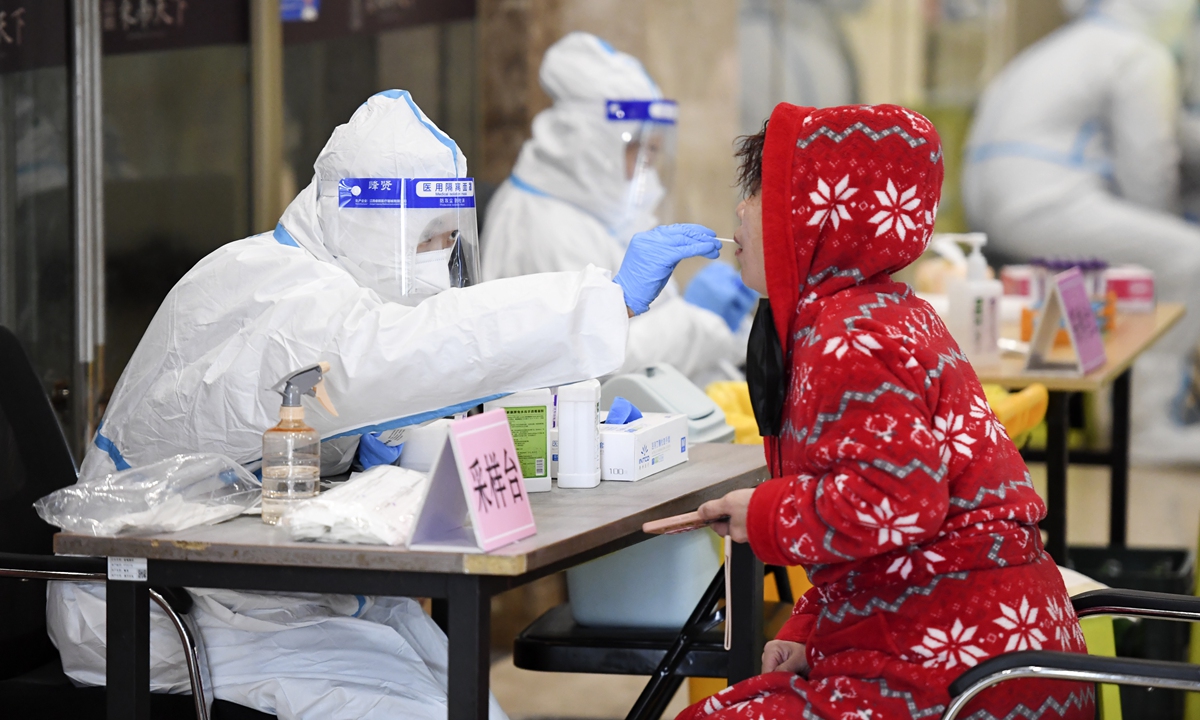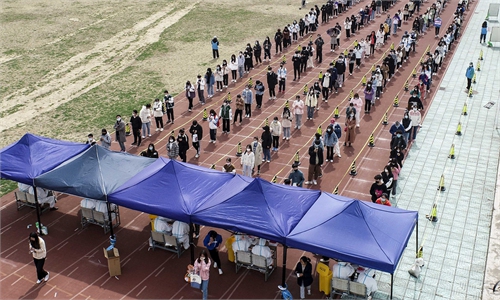China's anti-epidemic fight cannot and will not 'lie flat': Global Times editorial

A resident takes the nuceic acid testing in Changchun, Northeast China's Jilin Province on March 13, 2022 as the city has started a new round of citywide testing. Photo: VCG
On Tuesday, at a press conference of the State Council joint prevention and control mechanism against COVID-19, a spokesperson of China's National Health Commission said that local COVID-19 clusters have occurred in many places in China recently. Since March, the country has seen a rapid increase in the frequency of the outbreaks and the number of infections. This wave of the epidemic has affected 28 provinces and regions in the country. The current wave of the outbreak is characterized by more clusters, a wide area, and a high frequency of the emergence of new cases. Data shows the cumulative number of confirmed COVID-19 cases in the past three months has already exceeded the total number of last year. China is facing a serious and complicated challenge in the prevention and control of the epidemic.
At a time like this, we should even more firmly adhere to the general strategy of targeting both imported cases and domestic epidemic rebound and the general policy of dynamic zero-COVID. Even though the Omicron variant has spread forcefully, overall, it remains controllable. The number of new infections in China is at a record high in two years, but the percentage of the infected population is still extremely low if we compare the figure with other countries. More importantly, almost all Chinese are confident that the epidemic will eventually be eradicated, the number of confirmed cases will drop to zero in China, and a large-scale humanitarian disaster will not occur in the country.
Such a common expectation is based on the success of China's general strategy and approach to COVID-19 prevention and control. It has safeguarded people's lives and health to the greatest extent possible, as well as people's normal work and daily life, and the safety of the industrial supply chain. Prevention and control measures of the dynamic zero-case policy have proved to be effective in dealing with outbreaks caused by the Omicron variant. Of course, the highly transmissive and insidious nature of the Omicron variant requires us to take earlier, faster, stricter, and more solid control measures. In other words, we can't relax our epidemic prevention and control measures, and especially not in special times. Otherwise, all that has been achieved may go down the drain.
During the recent outbreak of COVID-19 cases in China, some Western media outlets again made waves of questioning China's dynamic zero-case policy. Some netizens in China were influenced by such hype and think China should act as the West to give up the dynamic zero-COVID policy and "lie flat" for the economy. But they won't mention that Western countries are not capable of taking a dynamic zero-COVID policy rather than not willing to. And they won't say how big a price of lives West has paid for its choice to "lie flat." Chinese people cannot afford to have tens of millions of infected people, China's healthcare system cannot withstand that while people have no normal socioeconomic life.
The dynamic zero-case policy is not tantamount to "no infections." Instead, it is aimed at putting the epidemic under control as soon as possible with maximum efforts and minimum costs through a precise prevention network. China's success in COVID-19 prevention is unquestionable no matter whether it is measured with data of infections, deaths or economic development. The Chinese National Bureau of Statistics said on Tuesday that China's main economic indexes recovered in January and February, showing a better economic recovery than expected. That is to say we have accumulated abundant experiences in epidemic control and prevention and taken effective measures to block the spread of the virus. The epidemic's impact on the economy will be gradually put under control.
It has been proven that the approach and its effects of China's anti-epidemic fight are good. In the fight against COVID-19, the state is able to integrate resources, the government is responsible to the people, and the people are willing to cooperate in epidemic fight methods - these are the biggest differences between China and the West. Of course, the dynamic zero-COVID policy is not unchangeable. Different-level governments are subject to higher-standard demands: They cannot take no action and cannot take wrong action. As the governments build defense lines against the epidemic, they must minimize the impact on enterprises and people's work and daily life while maximizing the social and economic development impetus.
In a word, China's epidemic fight cannot and will not "lie flat." Certainly, we have always been adjusting COVID-19 prevention and control measures according to the situation. On Tuesday, the National Health Commission released the latest version of the diagnosis and treatment protocol, with many significant updates in terms of COVID-19 testing, management and treatment. There is also much work to be done, including continuing to increase vaccination rates, accelerating the development of anti-COVID medicine, and establishing more comprehensive emergency response plans. We don't fight a battle without any preparation, and only by taking action beforehand will we be able to take the initiative in the COVID-19 prevention and control.

